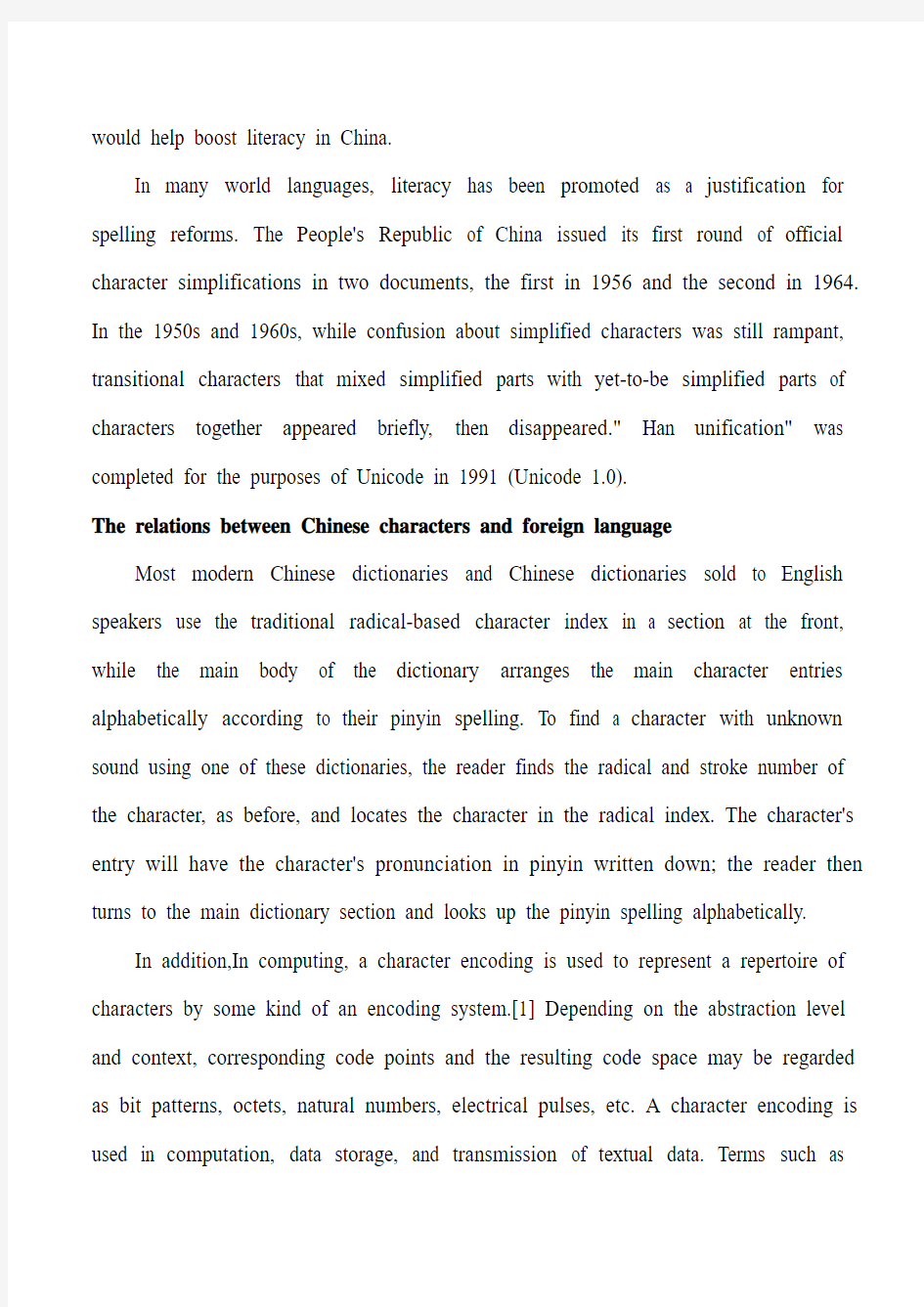Chapter VII


Five thousand years of Chinese characters Chapter VII Rejuvenation through Fire and Blood
The Evolution of Chinese characters in modern time
Chinese characters combine shapes with sounds and connotations to form unique, block-shaped characters that carry meaning. Archaeological researchers discovered many such signs carved on earthenware excavated from Banpo Village in Xi’an City and Jiangzhai Village in Lintong. The etchings were carved during the Yangshao Culture Period some 6,000 years ago. More than 4,000 years ago, people living in the Tai’an area of Shandong Province also carved signs on earthenware. The character “旦”(dan in pin yin, meaning dawn), for instance; the sun (日) rises upwards, crossing the mountains and passing through cloud layers to tell people a new day has begun. It is safe to say that the earthenware signs are the first Chinese characters, which originated from drawings.
Although most of the simplified Chinese characters in use today are the result of the works moderated by the government of the People's Republic of China (PRC) in the 1950s and 60s, character simplification predates the PRC's formation in 1949. One of the earliest proponents of character simplification was Lu Feikui, who proposed in 1909 that simplified characters should be used in education. In the years following the May Fourth Movement in 1919, many anti-imperialist Chinese intellectuals sought ways to modern China. In the 1930s and 1940s, discussions on character simplification took place within the Kuomintang government, and a large number of Chinese intellectuals and writers have long maintained that character simplification
would help boost literacy in China.
In many world languages, literacy has been promoted as a justification for spelling reforms. The People's Republic of China issued its first round of official character simplifications in two documents, the first in 1956 and the second in 1964. In the 1950s and 1960s, while confusion about simplified characters was still rampant, transitional characters that mixed simplified parts with yet-to-be simplified parts of characters together appeared briefly, then disappeared." Han unification" was completed for the purposes of Unicode in 1991 (Unicode 1.0).
The relations between Chinese characters and foreign language
Most modern Chinese dictionaries and Chinese dictionaries sold to English speakers use the traditional radical-based character index in a section at the front, while the main body of the dictionary arranges the main character entries alphabetically according to their pinyin spelling. To find a character with unknown sound using one of these dictionaries, the reader finds the radical and stroke number of the character, as before, and locates the character in the radical index. The character's entry will have the character's pronunciation in pinyin written down; the reader then turns to the main dictionary section and looks up the pinyin spelling alphabetically.
In addition,In computing, a character encoding is used to represent a repertoire of characters by some kind of an encoding system.[1] Depending on the abstraction level and context, corresponding code points and the resulting code space may be regarded as bit patterns, octets, natural numbers, electrical pulses, etc. A character encoding is used in computation, data storage, and transmission of textual data. Terms such as
character set, character map, code-set or code page are sometimes used as near synonyms; however, these terms have related but distinct meanings described in the article.
Chapter1会计概论答案
第一章会计透视:会计信息及其使用者▓复习思考题 1.概述会计的性质。 会计是按照会计规范确认、计量、记录一个组织的经济活动,运用特定程序处理加工经济信息,并将处理结果传递给会计信息使用者的信息系统,是组织和总结经济活动信息的主要工具。 会计是一个信息系统,会计处理的各个环节的加工的对象是会计信息。会计信息实际上是一种广义的信息,包含三个层次: 其一,以货币化指标体现的财务信息,它是从动态、静态两个角度,对特定主体经济资源的数量(资产)、归属(负债、所有者权益)、运用效果(收益分配)、增减变化及其结果(财务状况变动及其结果)进行描述; 其二,非货币化的和非数量化的说明性信息,它们不仅仅是对主体的财务状况、经营成果等财务指标的基本说明,而且还包含了大量的主体所处的社会、文化、道德、法律等环境信息,这些信息对于使用者正确判断主体的经营能力、发展前景,往往起到至关重要的作用; 其三,其他用于主体内部管理的信息,这些信息常常由成本会计、管理会计以及内部审计人员提供,主要包括了短期(长期)决策信息、预算信息、责任中心要求及履行情况等情况,虽然与外部性较强的财务会计信息相比,它们更容易为人们所忽略,但在经济管理和财务信息质量控制方面,它们也起了不可低估的作用。不过,在当前的会计报告模式中,所反映的会计信息主要是前两个层次上的信息。 2.企业的获利能力是否为债权人的主要考虑因素? 债权人关心那些影响自己的债权能否得到按期偿还的因素。他们会对公司的获利能力及清偿能力感兴趣。债权人会从获利能力去衡量未来的现金流量,由于企业的获利能力与现金流量并不一定同步产生,所以对短期债权人来说,企业的获利能力不能成为债权人的主要考虑因素,但对相对长期的债权人来说获利能力应该是值得更加关注的因素。 3.财务报表中体现出来的会计信息用以满足不同使用群体的需求,但并不是所有的使用者都能得到相同的满足的。在实践中,外部财务报表使用者诸如股东、供应商、银行等是如何获得有关公司的财务信息的?若要同时满足不同类别的财务报表使用者的信息需求有什么困难? 首先,股东是公司法定的所有者,法律上财务报表是为其制作的。法律规定,公司必须定期编制并发布财务报表,为其股东公布财务信息,我国《公司法》对此也有明确的规定。 其次,供应商与公司是商业伙伴关系,不提供商业信用的供应商,由于是钱货两讫,可通过报媒和网络了解公司公开财务的财务信息,如果供应商对公司提供商业信用,供应商可要求企业提供一定的财务信息,但对这些财务信息的准确性、可靠性需要有一定的分析。
